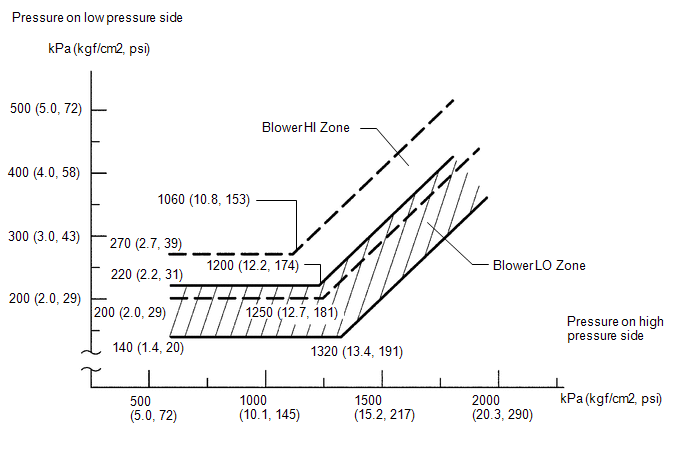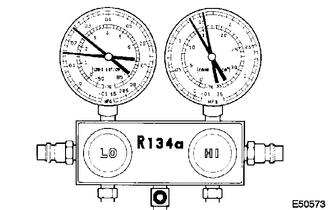Toyota 4Runner: On-vehicle Inspection
ON-VEHICLE INSPECTION
PROCEDURE
1. INSPECT REFRIGERANT PRESSURE WITH MANIFOLD GAUGE SET
(a) This method uses a manifold gauge set to locate problem areas. Read the manifold gauge pressure when these conditions are established.
Test conditions:
- Temperature the air inlet is 30 to 35°C (86 to 95°F).
- Engine is running 1500 rpm.
- All doors are fully open.
- Blower speed control switch is set to HI.
- Air inlet control set to RECIRC.
- A/C switch is on.
Gauge readings (Reference)

|
(1) Normally functioning refrigeration system. Gauge Reading:
|
|
(2) The A/C system periodically changes between normal and improper function due to moisture in the refrigerant system.

|
Symptoms |
Probable Cause |
Diagnosis |
Corrective Actions |
|---|---|---|---|
|
During operation, pressure on low pressure side cycles between normal and vacuum |
Moisture in refrigeration system freezes expansion valve orifice, causing temporary stop of cycle. However, when melted, normal state is restored. |
- Dryer is overly saturated - Moisture in refrigeration system freezes expansion valve orifice and blocks refrigerant circulation |
1. Replace cooler dryer 2. Remove moisture from cycle by repeatedly evacuating air 3. Supply appropriate volume of new refrigerant |
(3) The A/C system does not function effectively due to insufficient refrigerant.

|
Symptoms |
Probable Cause |
Diagnosis |
Corrective Actions |
|---|---|---|---|
|
- Pressure low on both low and high pressure sides - Cooling performance insufficient |
Gas leakage from refrigeration system |
- Insufficient refrigerant - Refrigerant leakage |
1. Check for gas leakage and repair if necessary 2. Supply appropriate volume of new refrigerant 3. If indicated pressure value close to 0 when connected to gauge, create vacuum after inspecting and repairing location of leakage |
(4) The A/C system does not function effectively due to poor circulation of the refrigerant.

|
Symptoms |
Probable Cause |
Diagnosis |
Corrective Actions |
|---|---|---|---|
|
- Pressure low on both low and high pressure sides - Frost exists on piping from condenser to A/C unit |
Refrigerant flow obstructed by dirt in condenser |
Condenser clogged |
Replace condenser |
(5) The A/C system does not function or functions intermittently because the refrigerant does not circulate.

|
Symptoms |
Probable Cause |
Diagnosis |
Corrective Actions |
|---|---|---|---|
|
- Vacuum indicated on low pressure side and extremely low pressure indicated on high pressure side - Frost or condensation seen on piping on both sides of condenser or expansion valve |
- Refrigerant flow obstructed by moisture or dirt in refrigeration system - Refrigerant flow obstructed by gas leakage from expansion valve |
Refrigerant does not circulate |
1. Check expansion valve refrigerant 2. Clean expansion valve by blowing air 3. Replace condenser 4. Evacuate air and charge appropriate volume of new refrigerant 5. For gas leakage from expansion valve, replace expansion valve |
(6) The A/C system does not function effectively due to overcharged refrigerant or insufficient cooling of the condenser.

|
Symptoms |
Probable Cause |
Diagnosis |
Corrective Actions |
|---|---|---|---|
|
Pressure extremely high on both low and high-pressure sides |
- Excessive refrigerant - Cooling performance of condenser insufficient |
- Condenser is dirty - Condenser fan motor is malfunctioning - Excessive refrigerant |
1. Clean condenser 2. Check condenser fan motor operation 3. If 1 and 2 are normal, check amount of refrigerant and supply appropriate volume of refrigerant |
(7) The A/C system does not function due to air in the refrigeration system.
CAUTION:
The low-pressure piping may be very hot and cause serious burns.

|
Symptoms |
Probable Cause |
Diagnosis |
Corrective Actions |
|---|---|---|---|
|
- Pressure extremely high on both low and high-pressure sides - Low-pressure piping is too hot to touch |
Air in refrigeration system |
- Air in refrigeration system - Vacuum purging insufficient |
1. Check if compressor oil is dirty or insufficient 2. Evacuate air and charge new refrigerant |
(8) The A/C system does not function effectively due to an expansion valve malfunction.

|
Symptoms |
Probable Cause |
Diagnosis |
Corrective Actions |
|---|---|---|---|
|
- Pressure extremely high on both low and high-pressure sides - Frost or condensation on piping on low-pressure side |
Problem with expansion valve |
- Excessive refrigerant in low pressure piping - Expansion valve open too wide |
Replace expansion valve |
(9) The A/C system does not function due to a defective compressor.

|
Symptoms |
Probable Cause |
Diagnosis |
Corrective Actions |
|---|---|---|---|
|
- Pressure extremely high on both low and high-pressure sides - Pressure extremely low on high pressure side |
Internal leakage in compressor |
- Compression failure - Leakage from damaged valve or sliding parts broken |
Repair or replace compressor |
 Refrigerant
Refrigerant
...
 Replacement
Replacement
REPLACEMENT
PROCEDURE
1. RECOVER REFRIGERANT FROM REFRIGERATION SYSTEM
(a) Start the engine.
(b) Turn the A/C switch on.
(c) Operate the cooler compressor while the engine speed is approximately ...
Other materials about Toyota 4Runner:
Washer Nozzle(for Front Side)
Components
COMPONENTS
ILLUSTRATION
On-vehicle Inspection
ON-VEHICLE INSPECTION
PROCEDURE
1. INSPECT WASHER NOZZLE SUB-ASSEMBLY
(a) With the engine running, check the position that the washer fluid hits the
windshield.
Standard:
Washer fluid h ...
System Description
SYSTEM DESCRIPTION
1. ENGINE IMMOBILISER SYSTEM DESCRIPTION
(a) The engine immobiliser system is designed to prevent the vehicle from being
stolen. This system uses a transponder key ECU assembly that stores the key codes
of authorized ignition keys. If ...

